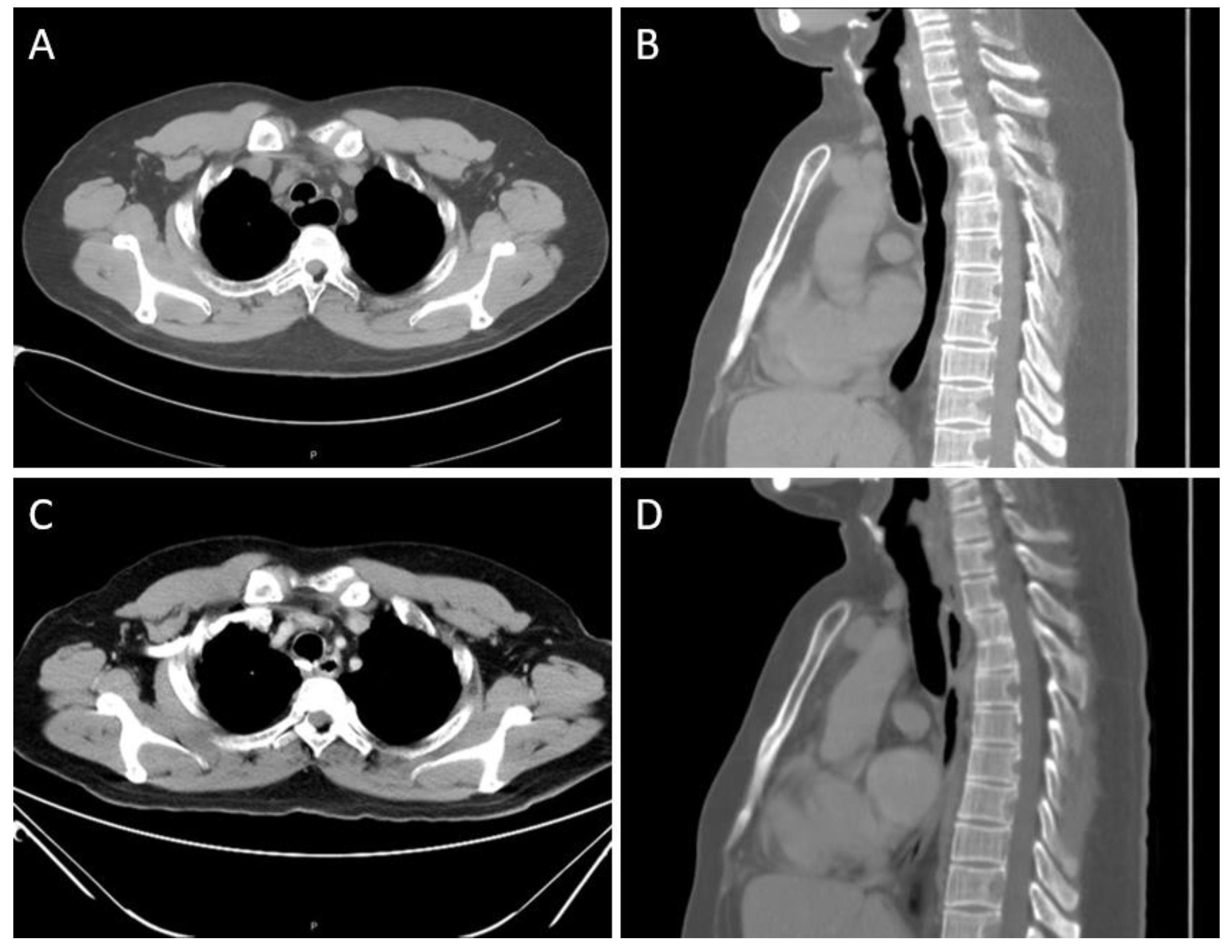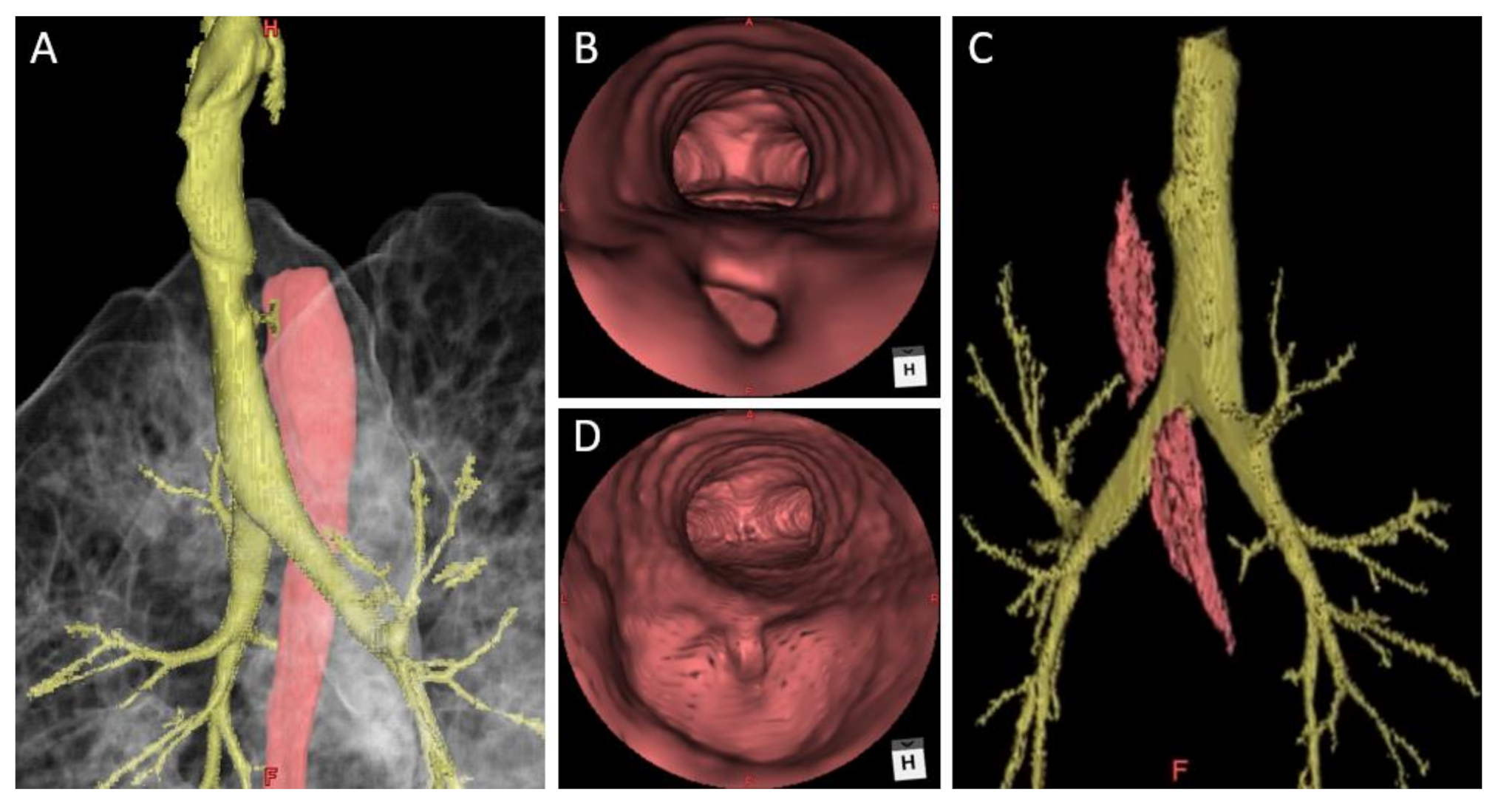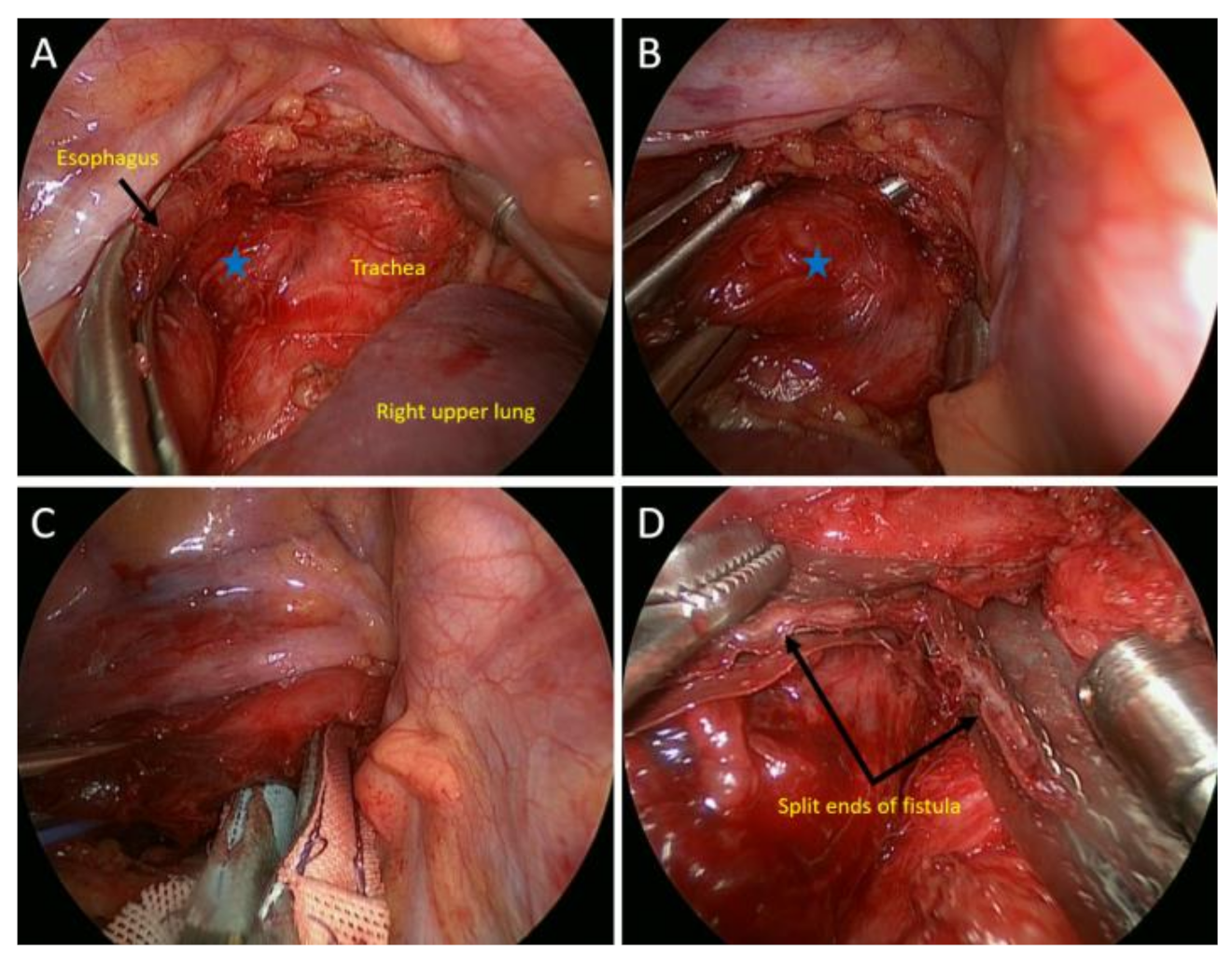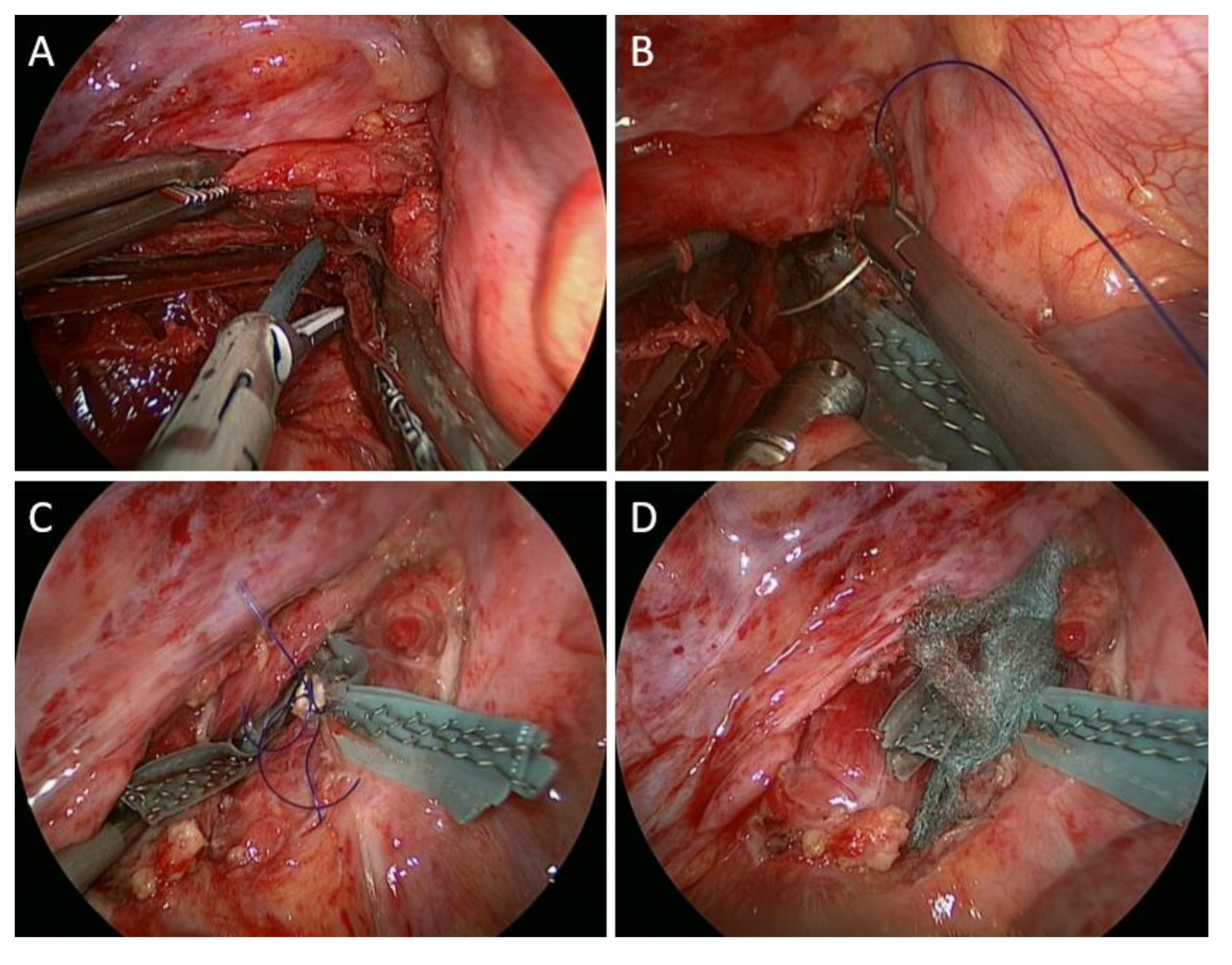Thoracoscopic Repair of Adult-Onset Congenital Tracheoesophageal Fistula Using a Polyglycolic Acid Sheet-Buttressed Stapler
Abstract
:1. Introduction
2. Case Report
3. Discussion
4. Conclusions
Author Contributions
Funding
Institutional Review Board Statement
Informed Consent Statement
Data Availability Statement
Conflicts of Interest
References
- Lamb, D.S. A fatal case of congenital tracheo-esophageal fistula. Phila. Med. Times 1873, 3, 705. [Google Scholar]
- Black, R.J. Congenital tracheo-oesophageal fistula in the adult. Thorax 1982, 37, 61–63. [Google Scholar] [CrossRef] [PubMed] [Green Version]
- Suen, H.C. Congenital H-type tracheoesophageal fistula in adults. J. Thorac. Dis. 2018, 10, S1905–S1910. [Google Scholar] [CrossRef] [PubMed]
- Garand, S.A.; Kareti, L.R.; Dumont, T.M.; Seip, C. Thoracoscopic repair of tracheoesophageal fistula in a septuagenarian. Ann. Thorac. Surg. 2006, 81, 1899–1901. [Google Scholar] [CrossRef] [PubMed]
- Salgaonkar, H.P.; Bhandarkar, D.S.; Sharma, P.C.; Chhakarvarty, N.; Ramadwar, R.; Mehta, R. Thoracoscopic repair of congenital tracheo-oesophageal fistula manifesting in an adult. J. Minim. Access. Surg. 2014, 10, 204–206. [Google Scholar] [PubMed]
- Kovesi, T.; Rubin, S. Long-term complications of congenital esophageal atresia and/or tracheoesophageal fistula. Chest 2004, 126, 915–925. [Google Scholar] [CrossRef] [PubMed] [Green Version]
- Acosta, J.L.; Battersby, J.S. Congenital tracheoesophageal fistula in the adult. Ann. Thorac. Surg. 1974, 17, 51–57. [Google Scholar] [CrossRef]
- VE, N. Specimen: OEsophagus from a Middle-aged Man, showing a Congenital Opening into the Trachea. Proc. R. Soc. Med. 1929, 22, 527. [Google Scholar]
- Holman, W.L.; Vaezy, A.; Postlethwait, R.; Bridgman, A. Surgical treatment of H-type tracheoesophageal fistula diagnosed in an adult. Ann. Thorac. Surg. 1986, 41, 453–454. [Google Scholar] [CrossRef]
- Azoulay, D.; Regnard, J.; Magdeleinat, P.; Diamond, T.; Rojas-Miranda, A.; Levasseur, P. Congenital respiratory-esophageal fistula in the adult. Report of nine cases and review of the literature. J. Thorac. Cardiovasc. Surg. 1992, 104, 381–384. [Google Scholar] [CrossRef]
- Newberry, D.; Sharma, V.; Reiff, D.; Lorenzo, F.D. A “little cough” for 40 years. Lancet 1999, 354, 1174. [Google Scholar] [CrossRef]
- Zacharias, J.; Genc, O.; Goldstraw, P. Congenital tracheoesophageal fistulas presenting in adults: Presentation of two cases and a synopsis of the literature. J Thorac. Cardiovasc. Surg. 2004, 128, 316–318. [Google Scholar] [CrossRef] [PubMed] [Green Version]
- Hajjar, W.M.; Iftikhar, A.; Al Nassar, S.A.; Rahal, S.M. Congenital tracheoesophageal fistula: A rare and late presentation in adult patient. Ann. Thorac. Med. 2012, 7, 48–50. [Google Scholar] [CrossRef] [PubMed]
- Downey, P.; Middlesworth, W.; Bacchetta, M.; Sonett, J. Recurrent and congenital tracheoesophageal fistula in adults. Eur. J. Cardiothorac. Surg. 2017, 52, 1218–1222. [Google Scholar] [CrossRef] [PubMed]
- Hayashibe, A.; Sakamoto, K.; Shinbo, M.; Makimoto, S.; Nakamoto, T. New method for prevention of bile leakage after hepatic resection. J. Surg. Oncol. 2006, 94, 57–60. [Google Scholar] [CrossRef] [PubMed]
- Maniwa, T.; Kaneda, H.; Saito, Y. Management of a complicated pulmonary fistula caused by lung cancer using a fibrin glue-soaked polyglycolic acid sheet covered with an intercostal muscle flap. Interact. Cardiovasc. Thorac. Surg. 2009, 8, 697–698. [Google Scholar] [CrossRef] [PubMed]
- Shinozaki, T.; Hayashi, R.; Ebihara, M.; Miyazaki, M.; Tomioka, T. Mucosal defect repair with a polyglycolic acid sheet. Jpn. J. Clin. Oncol. 2013, 43, 33–36. [Google Scholar] [CrossRef] [PubMed] [Green Version]
- Shigeeda, W.; Deguchi, H.; Tomoyasu, M.; Kaneko, Y.; Kanno, H.; Tanita, T.; Saito, H. The utility of the Stapler with PGA sheet for pulmonary wedge resection: A propensity score-matched analysis. J. Thorac. Dis. 2019, 11, 1546–1553. [Google Scholar] [CrossRef] [PubMed]
- Nakano, Y.; Takao, T.; Morita, Y.; Sakaguchi, H.; Tanaka, S.; Ishida, T.; Toyonaga, T.; Umegaki, E.; Kodama, Y. Endoscopic plombage with polyglycolic acid sheets and fibrin glue for gastrointestinal fistulas. Surg. Endosc. 2019, 33, 1795–1801. [Google Scholar] [CrossRef] [PubMed]




| Author | Publication Year | Age/Sex at Diagnosis | Preoperative Symptoms/Events | Diagnostic Investigation | Surgical Approach | Fistula Management | Outcome |
|---|---|---|---|---|---|---|---|
| Negus [8] | 1929 | 45/male | NA | Post-mortem examination | NA | NA | NA |
| Acosta et al. [7] | 1974 | 20/female | Productive cough/pneumonia | Esophagogram | Cervicotomy | Divided and primary closure | Uneventful |
| Black [2] | 1982 | 50/female | Productive cough/pneumonia | Esophagogram and bronchoscopy | Thoracotomy | Divided and primary closure | Uneventful |
| Holman et al. [9] | 1986 | 52/male | Productive cough/pneumonia | Esophagogram | Cervicotomy | Divided and primary closure | Uneventful |
| Azoulay et al. [10] | 1992 | NA (2 pts) | Productive cough/pneumonia | Esophagogram | Thoracotomy | Divided and primary closure | Uneventful |
| Newberry et al. [11] | 1999 | 46/male | Chronic cough/bronchitis | Esophagogram | Median sternotomy | Resected and interposed by fascia lata graft. | Uneventful |
| Zacharias et al. [12] | 2004 | - | - | - | - | - | - |
| Patient 1 | - | 45/female | Productive cough | Cine contrast study | Thoracotomy | Divided and primary closure | Uneventful |
| Patient 2 | - | 55/male | Chronic cough/bronchitis and pneumonia | CT | Cervicotomy | Divided and primary closure | Uneventful |
| Garand et al. [4] | 2006 | 79/female | Chronic cough/pneumonia | Esophagogram and bronchoscopy | VATS | Divided by stapler with blue cartridge and interposed by bovine pericardial graft | Uneventful |
| Hajjar et al. [13] | 2012 | 31/male | Chronic cough/pneumonia | CT | Cervicotomy | Divided by stapler and interposed by muscular flap | Uneventful |
| Salgaonkar et al. [5] | 2014 | 23/male | Chronic night-time regurgitation | CT | VATS | Divided by endoscopic stapler with blue cartridge and interposed by pleural flap | Uneventful |
| Downey et al. [14] | 2017 | 65/female | Chronic cough/pneumonia | Bronchoscopy | Cervicotomy | Divided, primary closure, and interposed by muscular flap | Uneventful |
| Suen [3] | 2018 | - | - | - | - | - | - |
| Patient 1 | - | 32/male | Chronic cough/pneumonia | Bronchoscopy and esophagoscopy | Cervicotomy | Divided, primary closure, and interposed by muscular flap | Uneventful |
| Patient 2 | - | 49/female | Shortness of breath/respiratory infection | Esophagogram | Cervicotomy | Divided, primary closure, and interposed by muscular flap | Uneventful |
| Patient 3 | - | 55/male | Chronic cough/pneumonia | CT | Cervicotomy | Divided by endo-GI stapler, primary closure, and interposed by muscular flap | Uneventful |
Publisher’s Note: MDPI stays neutral with regard to jurisdictional claims in published maps and institutional affiliations. |
© 2022 by the authors. Licensee MDPI, Basel, Switzerland. This article is an open access article distributed under the terms and conditions of the Creative Commons Attribution (CC BY) license (https://creativecommons.org/licenses/by/4.0/).
Share and Cite
Chou, P.-R.; Kao, C.-N.; Liu, Y.-W. Thoracoscopic Repair of Adult-Onset Congenital Tracheoesophageal Fistula Using a Polyglycolic Acid Sheet-Buttressed Stapler. Medicina 2022, 58, 843. https://doi.org/10.3390/medicina58070843
Chou P-R, Kao C-N, Liu Y-W. Thoracoscopic Repair of Adult-Onset Congenital Tracheoesophageal Fistula Using a Polyglycolic Acid Sheet-Buttressed Stapler. Medicina. 2022; 58(7):843. https://doi.org/10.3390/medicina58070843
Chicago/Turabian StyleChou, Ping-Ruey, Chieh-Ni Kao, and Yu-Wei Liu. 2022. "Thoracoscopic Repair of Adult-Onset Congenital Tracheoesophageal Fistula Using a Polyglycolic Acid Sheet-Buttressed Stapler" Medicina 58, no. 7: 843. https://doi.org/10.3390/medicina58070843
APA StyleChou, P.-R., Kao, C.-N., & Liu, Y.-W. (2022). Thoracoscopic Repair of Adult-Onset Congenital Tracheoesophageal Fistula Using a Polyglycolic Acid Sheet-Buttressed Stapler. Medicina, 58(7), 843. https://doi.org/10.3390/medicina58070843






